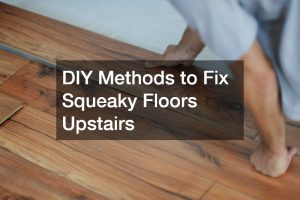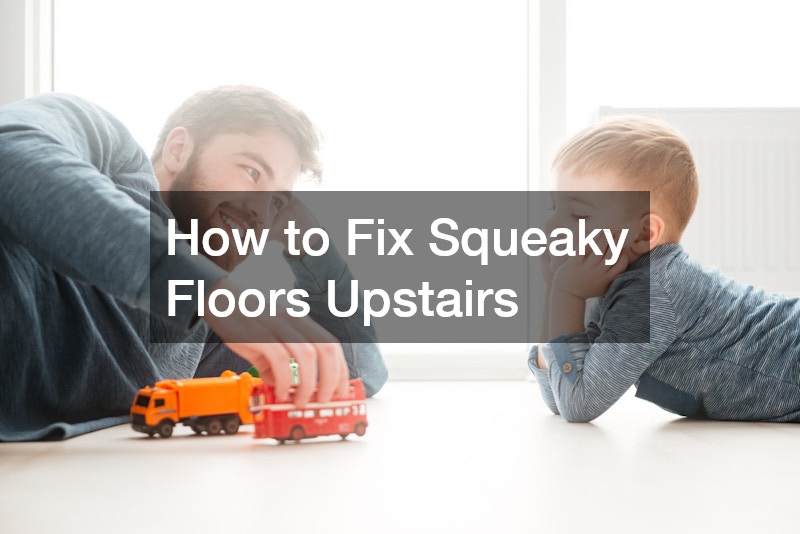Squeaky floors upstairs can be an annoying problem, especially when they disrupt the peace and quiet in your home. Every step can seem louder than the last, and if you’re dealing with squeaky floors in a two-story home, the noise might even travel downstairs. Luckily, fixing squeaky floors isn’t as difficult as it may seem. With a bit of know-how, you can quiet those creaks and enjoy a peaceful environment once again.
In this guide, we’ll explore how to fix squeaky floors upstairs and provide detailed, professional advice on making your floors less noisy. Additionally, we’ll address common causes, preventive measures, and tools required for the job.
Understanding the Causes of Squeaky Floors Upstairs
Before diving into the solutions, it’s essential to understand why floors squeak in the first place. Squeaky floors are typically caused by movement between the floorboards, subfloor, and joists. When the components of your floor rub against each other due to wear, age, or poor installation, squeaks occur.
Common Causes of Squeaky Floors:
- Loose Floorboards: Over time, floorboards can loosen and rub against nails or screws, creating squeaky sounds.
- Subfloor Issues: If the subfloor isn’t securely attached to the joists, it can cause movement and noise.
- Temperature and Humidity Changes: Seasonal changes can cause wood to expand and contract, leading to creaky floors.
- Poor Installation: Incorrect installation of floorboards or joists may lead to squeaking over time.
In some cases, homeowners may wonder, “Why does my house creak so much?” Creaks can be due to the natural settling of your home, especially if it’s older. However, frequent creaking could signal structural issues, so it’s important to assess the underlying causes.
Tools and Materials Needed to Fix Squeaky Floors
Before starting your project, gather the necessary tools and materials. Here’s what you’ll need:
Tools:
- Hammer
- Drill
- Screws
- Wood Glue
- Nail Set
- Shims
- Screwdriver
- Lubricant (powdered graphite or talcum powder)
- Pry Bar
Materials:
- Carpenter’s Glue
- Carpet Repair Kit (for fixing floors through carpet)
- Squeak-Ender Tool (optional but useful)
DIY Methods to Fix Squeaky Floors Upstairs

Fixing squeaky floors upstairs can often be accomplished with simple DIY methods. Below, we’ll guide you through several techniques for quieting noisy floors.
Using Powdered Lubricants
If the squeak is caused by friction between floorboards, a quick fix is to use a powdered lubricant such as graphite or talcum powder. Here’s how:
- Locate the squeaky spot: Walk around the area to identify where the squeak is most prominent.
- Apply lubricant: Sprinkle the lubricant between the floorboards.
- Work it in: Use a cloth to push the powder into the cracks.
- Test the floor: Walk over the area again to see if the squeak is reduced.
This method is a temporary fix but works well for small issues.
Securing the Subfloor from Below
One of the most effective ways to address squeaky floors is by reinforcing the subfloor from below. If you have access to the floor joists through a basement or crawlspace, follow these steps:
- Identify the joist: Pinpoint the joist causing the squeak by having someone walk on the floor while you’re underneath.
- Drill pilot holes: Use a drill to create small holes where the subfloor meets the joist.
- Insert screws: Drive screws into the subfloor to secure it firmly to the joists.
This method directly addresses the issue of loose subflooring.
Adding Support with Shims
In some cases, gaps between the subfloor and joists cause the noise. Adding shims to fill these gaps can prevent movement and silence the squeaks.
- Locate the gap: Identify where the gap between the joist and subfloor exists.
- Insert a shim: Carefully hammer a wooden shim into the gap.
- Glue the shim in place: Apply the carpenter’s glue to secure the shim.
Shims can provide the additional support needed to stop the floor from moving and squeaking.
Fixing Squeaky Floors Through Carpets

If your floor is carpeted, fixing the squeak requires a slightly different approach. You can use a carpet repair kit or a special tool like the “Squeak No More” kit.
- Locate the joist: Use a joist-finding tool to find the joist under the squeaky area.
- Install screws: Drive special screws through the carpet into the subfloor to secure it to the joist.
- Snap the screw head: These screws are designed to snap off below the carpet, leaving no visible mark.
This method is ideal for addressing squeaks in carpeted rooms without damaging the carpet.
When to Call a Professional
While many squeaky floor issues can be addressed with DIY methods, some problems require the expertise of a professional. If you’ve tried the above techniques and the squeak persists, or if the squeak is accompanied by structural concerns, it may be time to contact a home improvement expert.
Professionals can evaluate the problem in detail and provide solutions like re-installing subfloors or repairing joists. They also have specialized tools to tackle larger issues that homeowners may not be equipped to handle.
How to Prevent Squeaky Floors in the Future
Preventing squeaky floors is easier than you might think. Routine maintenance and attention to detail can go a long way toward keeping your floors quiet.
Preventive Maintenance Tips:
- Secure Loose Boards: Regularly check for loose boards and fasten them immediately.
- Use Proper Fasteners: When installing new floors, ensure that you’re using the appropriate nails or screws.
- Control Humidity: Keep your home’s humidity levels in check, as extreme changes can cause wood to expand or contract, leading to creaks.
Maintaining a regular home maintenance schedule can help keep potential problems from developing into major issues.
FAQ: Why Does My House Creak So Much?
If you’re frequently asking, “Why does my house creak so much?” it could be due to several factors. Wood naturally expands and contracts with changes in temperature and humidity, which can lead to creaking sounds, especially in older homes. Houses also settle over time, which can cause slight shifts in the structure and result in creaky floors and walls.
If your home creaks excessively, it might be worth consulting with a structural engineer to ensure there are no underlying issues with your foundation or framing.
Addressing Structural Problems with Squeaky Floors
If you’ve tried the DIY methods and the floor is still noisy, the issue may be more significant. Squeaky floors upstairs can sometimes be a sign of underlying structural problems. These might include:
- Damaged or Misaligned Joists: If the joists are warped, damaged, or not installed correctly, they can cause movement between the floorboards and subfloor. This is a common reason for squeaks in older homes.
- Foundation Settling: As your home settles over time, it can lead to shifts in the structure that cause floorboards to move and squeak. Settling is particularly common in houses built on clay or other types of soil that expand and contract with moisture levels.
- Incorrect Subfloor Installation: If your subfloor wasn’t properly installed, it might not be securely fastened to the joists, allowing gaps and movement that cause noise. This could require professional help to re-secure or even replace the subfloor.
In these situations, it’s best to hire a structural engineer or a contractor specializing in flooring to assess the issue. They may recommend reinforcing the joists, leveling the floor, or even adjusting the foundation.
How Flooring Materials Contribute to Squeaks
The type of flooring you have can also play a role in the likelihood of developing squeaks. Here’s how various materials might affect squeaky floors:
Hardwood Floors
Hardwood floors are beautiful but are also prone to squeaking due to the natural expansion and contraction of the wood. Seasonal changes in temperature and humidity can cause wood to shrink or swell, leading to movement between the boards. Over time, this movement can cause the nails or screws to loosen, resulting in squeaks.
Laminate Floors
Laminate flooring is often installed with an underlayment to create a cushion between the floor and subfloor. If the underlayment is too thin, uneven, or poorly installed, it can lead to noise as the floorboards move against the subfloor. Make sure that the underlayment is of high quality and properly installed to avoid squeaks.
Carpeted Floors
Carpet may mask squeaky floorboards, but it doesn’t prevent the subfloor or joists from moving underneath. Fixing squeaky floors under carpet is more challenging but can be addressed with the methods mentioned above. If you’re experiencing noise in a carpeted room, it’s often best to look under the floor to determine the problem.
Vinyl and Tile Floors
While vinyl and tile floors are less likely to squeak than hardwood or laminate, they can still develop noise if the subfloor beneath them is loose or damaged. Cracked tiles or loose adhesive can cause squeaks, which will require the tiles to be removed and reinstalled to fix the problem.
Advanced Tools and Techniques for Fixing Squeaky Floors
Sometimes basic tools aren’t enough to fix squeaky floors upstairs, especially if you’re dealing with large or persistent problem areas. Here are some advanced tools and techniques that professionals often use to solve squeaky floor issues:
Squeak-Ender Tool
This specialized tool is designed specifically for fixing squeaky floors. It consists of a bracket that attaches to the joist and is tightened with a screw to pull the subfloor tightly against the joist, eliminating any movement that causes the squeak.
Squeeeeek No More Kit
This is a popular tool for fixing squeaks under carpets. The kit allows you to locate the joist and drive special screws through the carpet into the subfloor without damaging the carpet. The screws are designed to snap off just below the surface, leaving no trace.
Nail Set and Hammer
Sometimes nails work their way loose over time and need to be reset. A nail set allows you to drive nails back into place without damaging the wood around them, reducing the noise caused by loose boards.
Structural Adhesives
In cases where floors are loose but not damaged, applying structural adhesive between the subfloor and joists can help eliminate movement and noise. This type of adhesive creates a long-lasting bond that prevents the subfloor from shifting and creaking.
Best Practices for Installing Squeak-Free Floors
If you’re renovating your home or installing new flooring, following best practices during installation can help prevent squeaks from developing later on. Here are some key tips:
Secure the Subfloor
When installing a new subfloor, make sure it’s firmly secured to the joists with screws rather than nails. Screws provide a tighter, more secure hold and are less likely to work their way loose over time. Make sure to use screws that are appropriate for the thickness of the subfloor.
Use the Right Underlayment
For laminate or hardwood flooring, always install a high-quality underlayment. The underlayment provides a cushion between the subfloor and the finished floor, reducing movement and noise. Ensure the underlayment is properly installed with no gaps or wrinkles that could cause the floor to move.
Allow for Seasonal Movement
When installing hardwood floors, leave a small gap around the perimeter of the room to allow the wood to expand and contract with changes in temperature and humidity. This prevents the boards from pressing against each other, which can lead to squeaks.
Tighten Fasteners
Before installing new flooring, inspect the subfloor and joists for loose nails or screws. Tighten any fasteners you find to prevent future movement and noise. Additionally, consider adding extra screws in high-traffic areas to provide additional support.
How Seasonal Changes Affect Squeaky Floors
One of the most common reasons homeowners ask, “Why does my house creak so much?” is due to seasonal changes. Wood naturally expands and contracts with temperature and humidity fluctuations, which can lead to creaky floors.
Winter Months
In the winter, the air tends to be drier, which causes wood to shrink. This can create gaps between floorboards and subfloor, leading to increased squeaks. If you notice that your floors are noisier in the winter, it could be due to a lack of moisture in the air.
Summer Months
In the summer, the increased humidity can cause wood to swell. While this expansion may reduce gaps between boards, it can also cause wood to press against other boards, creating friction and noise. Using a dehumidifier can help regulate moisture levels in your home during the warmer months.
Controlling Humidity
To minimize the impact of seasonal changes on your floors, consider investing in a whole-house humidifier for the winter and a dehumidifier for the summer. Keeping your home’s humidity levels consistent throughout the year can reduce the likelihood of squeaky floors.
Squeaky Floors as an Indicator of Larger Problems
Squeaky floors are often harmless and easily fixed, but in some cases, they can indicate larger structural problems. Here are some warning signs to watch for:
- Uneven Floors: If your floors are not level or have begun to sag, it could indicate a problem with the subfloor or joists. This may require more extensive repairs or even a structural assessment.
- Persistent Squeaks: If the squeak persists after multiple repairs, it could indicate that there’s a more serious issue, such as foundation settling or damaged joists.
- Visible Damage: If you notice cracks in the floorboards or gaps between the boards and walls, it could be a sign that the floor is shifting. In this case, it’s best to consult a professional.
Conclusion
Squeaky floors upstairs are a common issue in many homes, but they don’t have to be a permanent annoyance. You can quiet your floors and enjoy a peaceful home environment with the right tools, techniques, and preventive measures. Whether you’re using powdered lubricants, securing your subfloor from below, or employing advanced DIY methods like fixing squeaks through the carpet, there’s a solution for every type of floor.
And remember, if the squeak persists or if you suspect a more serious issue, it’s always best to consult with a professional. A quiet home isn’t just about comfort—it’s about ensuring the longevity and safety of your property. Now that you know how to fix squeaky floors upstairs, you’re on your way to maintaining a serene and sound-free living space.
Incorporating methods for fixing squeaky floors upstairs and understanding “why does my house creak so much” helps ensure a quieter and more comfortable home environment for everyone.

